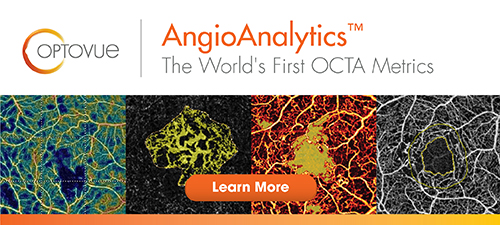FROM THE EDITORS OF REVIEW OF OPHTHALMOLOGY AND RETINA SPECIALIST:
Ranibizumab Induces DR Regression in Most Cases at High Risk of PDR Progression
Panretinal Photocoagulation vs. Intravitreous Ranibizumab for PDR
Anti-VEGF Therapy in DME: Real-world Outcomes Structural Neurodegeneration Correlates with Early Diabetic Retinopathy Safety & Efficacy of Anti-VEGF Therapies for Neovascular AMD OCT, FA & Diagnosis of CNV in AMD Macular Pigment Distribution as Prognostic Marker for MacTel Type 2 Progression Researchers evaluated macular pigment distribution pattern as a prognostic marker for disease progression in individuals with macular telangiectasia type 2, as part of a retrospective cohort study. They analyzed 90 eyes of 47 individuals in this single-center study, and measured pigment optical density with dual wavelength fundus autofluorescence. Independent graders (blinded) assigned eyes into MPOD distribution classes 1 to 3 with increasing loss of macular pigment. They defined best-corrected visual acuity, reading acuity, total scotoma size in fundus-controlled perimetry (microperimetry) and break of the ellipsoid zone in optical coherence tomography (en face measurement) as functional and morphologic outcome parameters, and evaluated the eyes at baseline and after 60 months. After a mean review period of 59.6 months (±SD 5.2 months), researchers found no change between MPOD classes compared with baseline. Morphologic and functional deficits were limited to the area of MPOD loss. At follow-up, they recorded a significant decrease of mean VA and reading acuity, as well as a significant increase of mean scotoma size and EZ break in eyes assigned to MPOD classes 2 and 3, while parameters remained stable in class 1 eyes. Researchers wrote that the results indicated that MPOD and its distribution might serve as a prognostic marker for disease progression and functional impairment in individuals with MacTel. SOURCE: Müller S, Issa PC, Heeren TFC, et al. Macular pigment distribution as prognostic marker for disease progression in macular telangiectasia type 2. Am J Ophthalmol 2018; Jul 24. [Epub ahead of print]. Comparison of Three Intravitreal Treatment Modalities of Macular Edema Due to BRVO Scientists compared the efficacy of intravitreal injections of ranibizumab and aflibercept, and dexamethasone implants for the management of macular edema related to branch retinal vein occlusion, as part of a retrospective and comparative study including 62 eyes of 62 individuals with BRVO and ME. Individuals received one of the following treatments: 0.5-mg ranibizumab (group 1, n = 22); 0.7 mg dexamethasone implant (group 2, n = 20); or 2-mg aflibercept (group 3, n = 20). The six-month treatment protocol in groups 1 and 3 consisted of three-dose loading treatments for the first three months, followed by repeat injections based on clinical necessity. Group 2 received only a single dose of 0.7 mg dexamethasone implant for six months. Visual acuity, central macular thickness, serous retinal detachment height and intraocular pressure measurements were performed at baseline and the first six months of follow-up. At baseline, the groups didn’t differ in age, gender, duration of ME, VA, CMT, IOP or SRD height (p>0.05). Mean number of injections per eye within six months were 3.64 ±0.49 (range: 3 to 4) in group 1; one in group 2 and 3.35 ±0.49 (range: 3 to 4) in group 3. VA was significantly better in group 2 in the first three months, but it became the worst among the three groups in the sixth month. CMT didn’t differ between groups in the first three months, but it was significantly higher in group 2 at the sixth month. SRD height was significantly lower in group 2 in the first three months, but there was no difference between the groups at the end of the sixth month. IOP was significantly higher in group 2 in the third and sixth months. Scientists wrote that, in the treatment of ME associated with BRVO, the dexamethasone implant appeared to be more advantageous in terms of VA and SRD height for the first three months. However, they added, at the end of the sixth month of treatment, anti-VEGF drugs were more efficient in maintaining the increased VA and reduced CMT. As such, scientists further wrote that dexamethasone implants might be a prudent first treatment option in BRVO cases with high SRD. SOURCE: Kaldırım HE, Yazgan S, et al. A comparison of three different intravitreal treatment modalities of macular edema due to branch retinal vein occlusion. Int Ophthalmol. 2018;38:4:1549-58. Segmentation Errors & Motion Artifacts in OCTA in Different Diseases In a retrospective analysis, scientists assessed the prevalence of segmentation errors and motion artifacts in optical coherence tomography angiography in different retinal diseases. Multimodal retinal imaging, including OCTA, was performed in one eye of 57 healthy controls (50.96 ±22.4 years) and 149 individuals (66.42 ±14.1 years) affected by different chorioretinal diseases: • early/intermediate age-related macular degeneration (n=26); • neovascular AMD (n=22); • geographic atrophy due to AMD (GA; n=6); • glaucoma (n=28); • central serous chorioretinopathy (n=14); • epiretinal membrane (n=26); • retinal vein occlusion (n=11); and • retinitis pigmentosa (n=16). Central 3 × 3 mm2 OCTA imaging was performed with active eye-tracking (AngioVue, Optovue). Best-corrected visual acuity and signal strength index were recorded. Images were independently evaluated by two graders using the OCTA motion artifact score (MAS; score of I to IV), as well as a newly introduced segmentation accuracy score (score I to IIB). Mean SSI was 63.67 ±9.2 showing a negative correlation with increasing age (rSp=-0.42, p<0.001, n=206). The study’s findings included the following: • In the healthy cohort, mean MAS was 1.45 ±0.8 and segmentation was accurate (SAS I) in all eyes. In eyes with retinal pathologies, mean MAS was 2.1 ±0.9 (p<0.001). The lowest MAS was observed in GA (2.67 ±0.5) and RVO (2.45 ±1.1). • Compared with an accurate segmentation in 100 percent of healthy subjects, 34.2 percent (n=51) of all individuals showed the highest segmentation quality (p<0.001). • A total of 63.8 percent showed segmentation errors in more than 5 percent of all single B-scans in one (SAS IIA, n=58) or at least two (SAS IIB, n=40) segmentation boundaries. The highest percentage of inaccurate segmentation (SAS IIA or IIB) was observed in the nAMD group (90.1 percent). The inner plexiform layer was the segmentation boundary most prone to inaccurate segmentation in all pathologies compared with the inner limiting membrane and retinal pigment epithelium segmentation layer. Incorrect ILM segmentation was only seen in individuals with EM. Scientists wrote that, prior to both qualitative and quantitative analysis, OCTA images must be carefully reviewed, as motion artifacts and segmentation errors in OCTA technology were frequent, particularly in pathologically altered maculas. SOURCE: Lauermann JL, Woetzel AK, Treder M, et al. Prevalences of segmentation errors and motion artifacts in OCT-angiography differ among retinal diseases. Graefes Arch Clin Exp Ophthalmol 2018; July 7. [Epub ahead of print]. Fractal Dimension & OCTA Features of Central Macula After RRD Repair |
||||||||||||||||||
AI Equal to Experts in Detecting Eye Diseases Researchers Reverse Congenital Blindness in Mice Researchers, funded by the National Eye Institute, reversed congenital blindness in mice by changing Müller glia in the retina into rod photoreceptors, as reported in Nature. In the first phase of a two-stage reprogramming process, researchers spurred Müller glia in normal mice to divide by injecting their eyes with a gene to turn on a protein called beta-catenin. Weeks later, they injected the mice’s eyes with factors that encouraged the newly divided cells to develop into rod photoreceptors. The researchers found that the newly formed rod photoreceptors looked structurally no different from real photoreceptors and synaptic structures that allow the rods to communicate with other types of neurons had also formed. In mice with congenital blindness, Müller glia-derived rods developed just as effectively as they had in normal mice, and the newly formed rods communicated with other types of retinal neurons across synapses. Light responses recorded from retinal ganglion cells and measurements of brain activity confirmed that the newly formed rods were integrating in the visual pathway circuitry. Researchers are now conducting behavioral studies to determine whether the mice regained the ability to perform visual tasks such as a water maze task and will eventually see if the technique works on cultured human retinal tissue. Read more. Source: National Eye Institute, August 2018
Meiragtx AAV-CNGA3 Receives FDA Orphan Drug Designation MeiraGTx Holdings announced that the FDA granted orphan drug designation for its AAV-CNGA3 gene therapy product candidate for the treatment of achromatopsia caused by mutations in the CNGA3 gene. AAV-CNGA3 is an investigational gene therapy treatment delivered to the cone receptors via subretinal injection and designed to restore cone function. In June 2018, the European Medicines Agency’s Committee for Orphan Medicinal Products issued a positive opinion recommending orphan medicinal product designation for AAV-CNGA3 for the treatment of ACHM. Read more. Source: MeiraGTx Holdings, August 2018 New Visual Tool May Help Screen for Alzheimer’s Researchers have a promising new screening tool for Alzheimer’s disease via information about the eye. A study of 3,877 randomly selected cases found a significant link between Alzheimer’s and three degenerative eye diseases: age-related macular degeneration; diabetic retinopathy; and glaucoma. The researchers from the University of Washington School of Medicine, the Kaiser Permanente Washington Health Institute and the UW School of Nursing reported their findings in the Aug. 8 online edition of Alzheimer’s & Dementia: The Journal of the Alzheimer’s Association. Participants, ages 65 and older, didn’t have Alzheimer’s during enrollment and were part of the Adult Changes in Thought database. Over the five-year study, of 792 cases of diagnosed Alzheimer’s, individuals with AMD, DR or glaucoma were at 40 percent to 50 percent greater risk of developing Alzheimer’s compared with people without the eye conditions. Researchers said more research is necessary, but a better understanding of neurodegeneration in the eye and brain could bring more accurate, earlier diagnosis of Alzheimer’s and the development of better treatments. Read more. Source: UW School of Medicine, August 2018 AMD Treatment May One Day Include Eye Drops Eye drops may one day be an option for age-related macular degeneration treatment, according to a recent study in Investigative Ophthalmology & Visual Science. Researchers developed a way to topically deliver ranibizumab and bevacizumab that, in an animal model, provided the same outcomes as injected therapy. Researchers used drops with cell-penetrating peptide-mediated topical delivery to transport anti-vascular endothelial growth factor therapy into the posterior segments of rabbit and pig eyes—more similar to human eyes than rodent eyes—which were tested in a similar study last year. In the previous study, rodents that had an anti-VEGF intravitreal injections and CPP plus the anti-VEGF eye drops had significantly lower areas of neovascularization than negative control eyes. The latest study showed that the drops had a similar therapeutic effect in mammal eyes. Read more. Source: University of Birmingham, July 2018 Wills Eye Sponsors Feasibility Study of Implantable Device for RP Wills Eye Hospital received U.S. FDA approval to begin an early feasibility study to implant the Retina Implant Alpha AMS subretinal device in individuals who are blind due to retinitis pigmentosa. Manufactured by Retina Implant AG, Reutlingen, Germany, the device was designed to replace non-functioning and absent photoreceptor cells lost to RP deterioration. A surgically implanted Alpha AMS chip stimulates the remaining components of the visual system to restore limited functional vision in blind RP individuals, the company says. The RI Alpha AMS is an investigational device in the United States and received CE Mark approval in Europe in 2016. Read more. Source: Wills Eye Hospital, August 2018 |
Review of Ophthalmology's® Retina Online is published by the Review Group, a Division of Jobson Medical Information LLC (JMI), 11 Campus Boulevard, Newtown Square, PA 19073. To subscribe to other JMI newsletters or to manage your subscription, click here. To change your email address, reply to this email. Write "change of address" in the subject line. Make sure to provide us with your old and new address. To ensure delivery, please be sure to add reviewophth@jobsonmail.com to your address book or safe senders list. Click here if you do not want to receive future emails from Review of Ophthalmology's Retina Online. |


